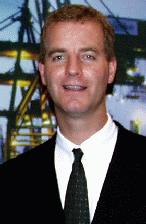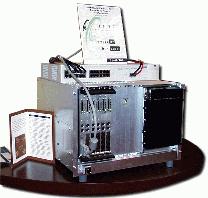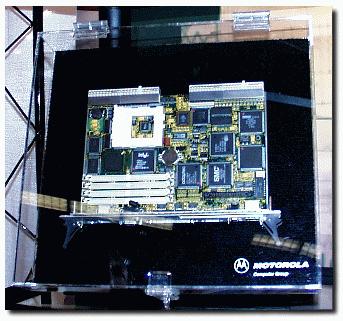
I talked to Lyle Ball of Lineo to find out which rumors were true.

On July 20, Caldera Thin Clients announced it was changing its name to Lineo and would be offering an embedded system product called Embedix, based on Caldera's OpenLinux. Then the rumors began to fly—who were they partnering with? The name heard most often was Motorola. On August 4, under an NDA until the August 9 announcement, I talked to Lyle Ball of Lineo to find out which rumors were true. Here's our conversation.
Margie: Sounds like exciting things are going on at Lineo. Tell us about it.
Lyle: On Monday, we will be publically announcing a strategic relationship between two Linux companies. Caldera Systems will be providing Motorola with OpenLinux for their high-availability network solutions, and for now, Lineo will be the only company working with Motorola in this way. We will be providing them with Embedix, which is Lineo's Linux platform for the embedded market.
Embedix is exclusively based on OpenLinux, and that exclusivity works both ways. Caldera Systems will not be partnering with anyone else in the embedded space and will not be providing the embedded Linux business—that will all be taken care of through Embedix and Lineo. We will not be using anyone else's solution. We won't, for instance, offer a Red Hat Linux solution as an alternative. So, from a technology standpoint, we will be taking Caldera Systems' OpenLinux platform into the Embedix arena. From a business standpoint, it is Lineo's Embedix that will be branded in that arena. Is that confusing or clear?

Margie: Very clear, you said it well.
Lyle: The big news here is that the world's largest provider of embedded technologies, Motorola, has selected Lineo and Caldera Systems as the software partners to launch Motorola's aggressive Linux initiative. Motorola will be providing Linux-based solutions from top to bottom—from their larger high-availability solutions all the way down to their smallest chips. Lineo will be providing the smaller space pieces, i.e., the embedded software pieces, under the brand name Embedix, and Caldera Systems will be directly providing the OpenLinux product for the high-end box, high-availability Linux solution.
Margie: This really sounds like hot stuff!
Lyle: It is big for us and we think it is really big for Linux. Companies have invested in other companies before—Red Hat has provided great exposure for Linux in investments. I personally believe this very high-level delivery of products presents a different perspective. For a world-leading embedded provider of hardware to make the investment and the commitment to target Linux—not just announcing a strategy, but actually doing it—is a big story. We will be doing just this as partners—actually presenting the products that will be delivered with their solutions. I'm very excited about Monday (August 9) and all the Linux news, such as Red Hat going public and our announcement. I'm sure a ton of other announcements will also be made at Linux World; it's going to be a very good Linux week. We are excited to contribute to that with this announcement.
We have been fighting hard for years. I've been in this for five years now at Caldera and then on to Lineo, and I'm just very excited this is coming out—moving forward.

Margie: How long have y'all been working on this embedded thing—not for five years, surely!
Lyle: Not for five years, but Lineo has been working on it for some time. The product is in progress, it's not a philosophy, it's not a white paper, it's product. If you want to understand our product, a press release I wrote is at www.lineo.com and talks about renaming Caldera Thin Clients to Lineo and the Embedix product. Embedix has over 130 components, and many of them are complete. OEMs (original equipment manufacturers) will build solutions based on any combination of those components. We already have OEMs working with these—Motorola is the first that is ready to announce. In the embedded OEM space, they don't announce their intention until they basically have the product done, because they don't want their competitors to know what they are doing.
Margie: I have seen your announcement, and my question is: which OEMs are already signed up?
Lyle: We can't say. It's not like in the software-only arena where Microsoft will vaporware their product a year and a half before they build it. Because of their dominance, they can do that. In the hardware arena where things can be copied so quickly, software components can be added into existing hardware. They don't want to talk about it until they are close to shipping it. Motorola is our first OEM to announce, but it is definitely not our last!
Margie: It's definitely a big one, too. What kinds of tools are included in Embedix?
Lyle: In general terms, we have taken Linux and optimized it for three areas required by OEMs: memory, storage and performance. We have optimized Linux technologies, in our case based exclusively on OpenLinux, to meet the rigorous demands in the restricted embedded space, where memory, storage and performance are all very critical. For instance, in the software desktop and PC arena, there is basically unlimited memory and speed and storage at this point. You can add on another terabyte or gigabyte, whatever you want—it costs, but you can do it. In the embedded space, the idea is how small you can get it, not how big. It's not how many more Linux packages I can add to make my product bigger and better than my competitor. It's how much tighter and smaller I can make my product and still have it do more than my competitor. It's the exact opposite philosophy of where Linux has been going in the last few years.
Margie: Did you have any problems with getting it stripped down to size?
Lyle: Of course, there were problems! Engineering is not an easy task! But we feel we are well ahead of any known competitors. First of all, we don't know of anyone of significance who has announced their actual product plans. A couple of small companies have announced they are going to try embedded Linux initiatives in software. None of them have a large partner like Motorola, to our knowledge. Again, we might be surprised on the 9th!
We do believe we are the first to market with embedded solutions, and we will aggressively define the embedded Linux space. We won't be the only one doing that, but we believe we will be integral to defining that space. And we believe we have a great chance at maintaining market leadership in that space, because we have been doing embedded for a few years and Linux for five. It's a unique evolution for Caldera Thin Clients, where we have a Linux heritage and a Linux sister company. We also have very deep experience with embedding DR DOS, and we've been making millions from that. So we are in a unique position: we are not a startup and we have funding. Our DOS product paid for all our R&D on embedded Linux. We have the processes in place, we have the employees, and we are simply evolving our focus from an embedded DOS-only company to an embedded Linux company.
Margie: Have y'all been doing this for a while?
Lyle: Oh, yes, it's been in the plans—just not public. You don't want your competitors to know everything you are doing.
Margie: How about the name change? How did you choose Lineo?
Lyle: We wanted a name that was more attached to the Linux environment, because we see a longer-term demand for Linux from the market. We are not killing our DOS product immediately; that is, the market is not killing our DOS product. There is still a high demand for embedded DOS, and we will continue to sell and market it. However, there has been an increasing demand for embedded Linux. So we are shifting our focus and renaming the company to match our longer-term revenue stream, which will be Linux-based.
Let me make it clear that we are not abandoning DOS, we are just shifting as the market has requested us to do. No one said, “Kill DOS now!” They said, “Hey, we need DOS, but, long term we would really like to have these Linux solutions as well.” It will be up to each individual OEM as to when they will switch over. Motorola is doing it now, and others will do it later. We will keep selling both technologies during the transition.
Margie: This may be a rather obvious question: when Cygnus decided to get into the embedded business, they did their own operating system and said that Linux wasn't going to work for them...
Lyle: Too bad for them!
Margie: What choices did y'all go through; did you decide to use Linux just because you had OpenLinux right there, or did you have other reasons?
Lyle: Well, one of the reasons was Caldera Systems has been very effective in building a solid brand around OpenLinux. OpenLinux is known as “Linux for Business”, and it's got this corporate and trusting feel to it. There may be weaknesses the product has, as all products have strengths and weaknesses, but its strength is that it has a solid name in the business community. Caldera has spent—I don't know if they have ever disclosed how much—an insane amount of money in advertising and other promotion to build Linux itself and OpenLinux as acceptable in a business setting. Therefore, when we spoke to our OEM companies—not just in the U.S., but around Europe and Asia—they were interested in our DOS solution and they would also say, “Boy, we would like an OpenLinux-based solution. We would like to switch to Linux, and we want to switch to a Linux that has a name and is comfortable and established. That way, we aren't perceived as bringing something new to the table—it's an evolution rather than a startup.” So the philosophy is that Caldera Systems has done a phenomenal job of building market awareness and a solid brand. Embedix is the business brand that Lineo will build, because we need our own brand. But it will always be accompanied with the tag “exclusively based on OpenLinux and licensed from Caldera Systems”. Embedix isn't licensed from Caldera Systems; Lineo owns its enhancements. Just as Red Hat and Caldera Systems always give credit to Linus for the Linux they have built their systems on, we will always give credit to OpenLinux for the base. We will call our additions—we actually call them “additions” even though we are making OpenLinux smaller in size; it's definitely advancements because it takes a lot of engineering to do so—our enhancements, “Embedix”.
Margie: Thanks for your time.